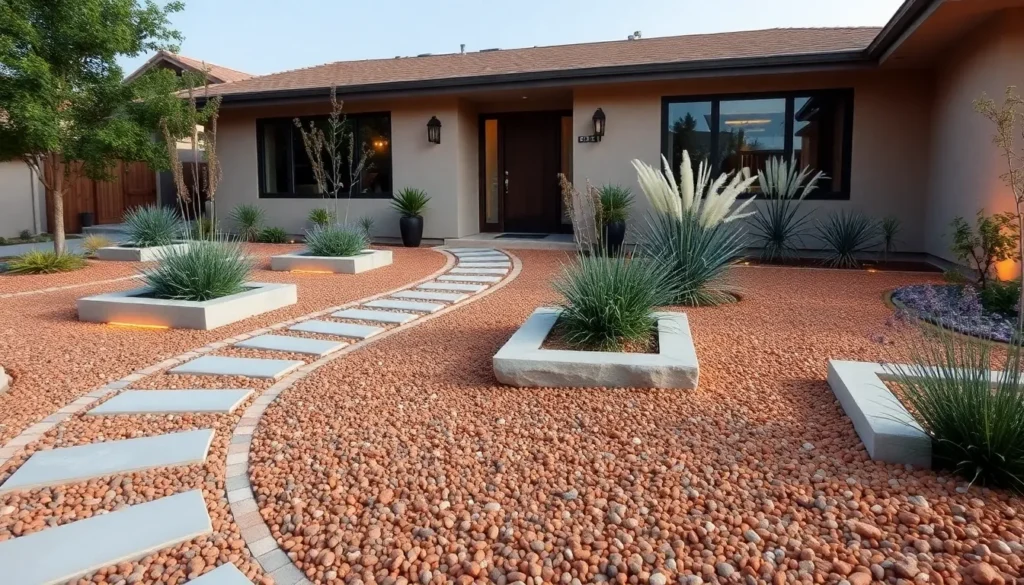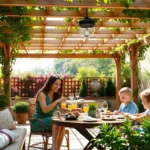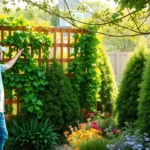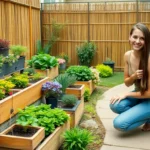Transform your front yard into a stunning low-maintenance masterpiece with gravel landscaping that’ll make your neighbors stop and stare. We’ve discovered that gravel gardens aren’t just practical – they’re absolutely gorgeous when designed thoughtfully.
Gravel gardens offer the perfect solution for busy homeowners who want maximum curb appeal with minimal upkeep. From modern minimalist designs to rustic cottage-style arrangements, these versatile stones create texture and visual interest while requiring virtually no watering or mowing.
We’re excited to share our favorite gravel front garden ideas that’ll help you create an outdoor space that’s both beautiful and budget-friendly. Whether you’re dealing with poor soil, drought conditions, or simply want to reduce your yard maintenance time, these creative designs prove that gravel can be the star of your landscaping show.
Create a Modern Minimalist Entrance With Clean Gravel Lines
Modern minimalist design transforms your front garden into a sleek and sophisticated space. Clean gravel lines provide the perfect foundation for contemporary landscaping that emphasizes simplicity and function.
Choose Light-Colored Gravel for Contemporary Appeal
Light-colored gravel creates the crisp and bright aesthetic that defines modern minimalist design. White marble chips, pale limestone, and light gray crushed stone reflect sunlight and make your entrance appear larger and more welcoming. We recommend using gravel sizes between 10mm to 20mm for optimal visual impact and easy maintenance.
Cream-colored pea gravel offers excellent drainage while maintaining the clean look you’re seeking. This neutral backdrop allows architectural features and carefully selected plants to take center stage. Light tones also help prevent heat absorption, keeping your walkways comfortable during summer months.
Add Geometric Planters for Structured Design
Geometric planters introduce vertical elements that complement your gravel’s horizontal flow. Square concrete planters, rectangular steel containers, and cylindrical fiber cement pots create strong architectural lines that enhance the minimalist aesthetic. We suggest using planters in matching materials like brushed aluminum or powder-coated steel for visual consistency.
Strategic placement of these containers defines spaces without cluttering your design. Position larger planters at entry points and smaller ones along pathways to guide visitors naturally toward your front door. Fill them with structural plants like ornamental grasses, boxwood spheres, or succulent arrangements that maintain their shape year-round.
Install LED Strip Lighting Along Pathways
LED strip lighting transforms your gravel pathways into stunning nighttime features. These low-profile lights can be embedded directly into the gravel or installed along planter edges to create subtle illumination that highlights your garden’s clean lines. We recommend warm white LEDs (3000K) for a welcoming glow that complements most architectural styles.
Solar-powered strip lights offer an eco-friendly option that requires no electrical wiring. Install them along the borders of your gravel areas or beneath planter rims to create floating effects. The gentle lighting enhances safety while maintaining the sophisticated ambiance that makes modern minimalist gardens so appealing.
Design a Mediterranean-Inspired Gravel Courtyard
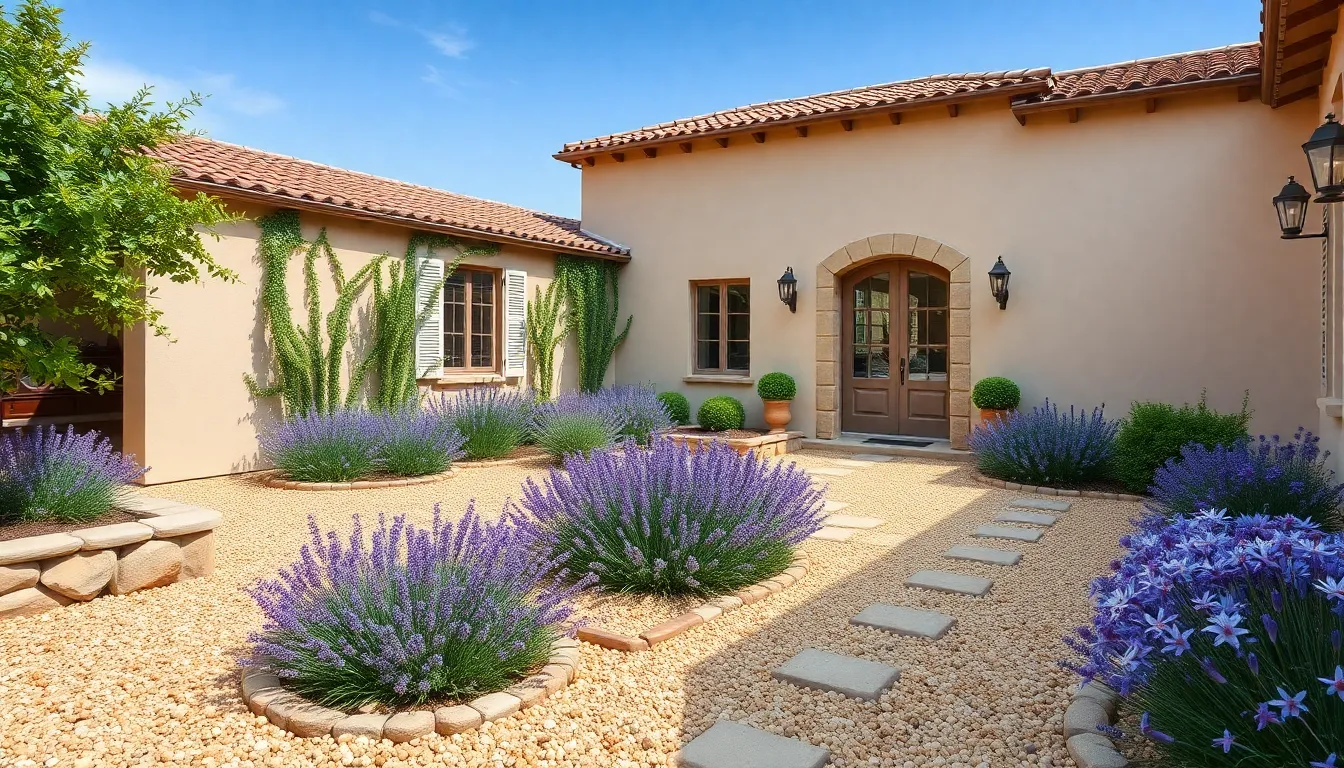
Transform your front yard into a sun-kissed Mediterranean oasis that captures the warmth and beauty of coastal landscapes. This timeless design approach creates an elegant entrance that’s both visually stunning and incredibly low maintenance.
Use Warm Terra Cotta and Cream Gravel Tones
Warm terra cotta and cream gravel tones create the perfect foundation for your Mediterranean-inspired courtyard. These earthy colors evoke the sun-drenched landscapes of the Mediterranean coast and add instant warmth to your entrance. We recommend mixing these tones in varying proportions to create depth and visual interest throughout your space.
Color layering works particularly well when you use cream gravel as your base layer and accent with terra cotta pieces. This combination creates a natural flow that mimics the weathered stone pathways found in traditional Mediterranean villages. The warm palette also complements most home exteriors while maintaining year-round appeal.
Texture variation becomes more pronounced when you combine different sizes within the same color family. Consider using 10mm cream gravel for pathways and larger 20mm terra cotta stones for decorative borders. This size variation adds dimension while keeping your color scheme cohesive and sophisticated.
Incorporate Drought-Resistant Plants Like Lavender
Lavender serves as the perfect centerpiece for Mediterranean gravel gardens due to its drought-resistant nature and aromatic properties. This hardy plant thrives in sandy, well-draining soil conditions that gravel gardens naturally provide. We suggest planting lavender in clusters of three or five for maximum visual impact.
Alliums and agapanthus ‘Northern Star’ complement lavender beautifully while maintaining the Mediterranean theme. These plants flourish in light, sandy soils and require minimal watering once established. Alliums provide striking purple spherical blooms that create vertical interest, while agapanthus offers elegant blue and white flowers.
Plant placement should follow natural groupings rather than formal rows to achieve an authentic Mediterranean feel. Space drought-resistant plants strategically throughout your gravel courtyard to create focal points while allowing the warm-toned stones to serve as a unifying element between different plant clusters.
Add Natural Stone Borders for Definition
Natural stone borders provide essential structure and definition to your Mediterranean gravel courtyard design. These borders create clear boundaries between different garden areas while adding textural contrast to the smooth gravel surfaces. We recommend using limestone or sandstone that complements your terra cotta and cream color palette.
Border placement should guide the eye naturally through your front garden space while creating logical pathways and seating areas. Install stone borders along walkways, around plant groupings, and to separate your courtyard from lawn areas. This creates a polished, intentional look that elevates your entire front yard design.
Stone selection impacts both aesthetics and functionality in your Mediterranean courtyard. Choose stones that are 6-8 inches wide for substantial visual weight while remaining proportional to your front garden size. Natural variations in color and texture add authenticity and prevent your design from appearing too uniform or artificial.
Build a Low-Maintenance Japanese Zen Garden
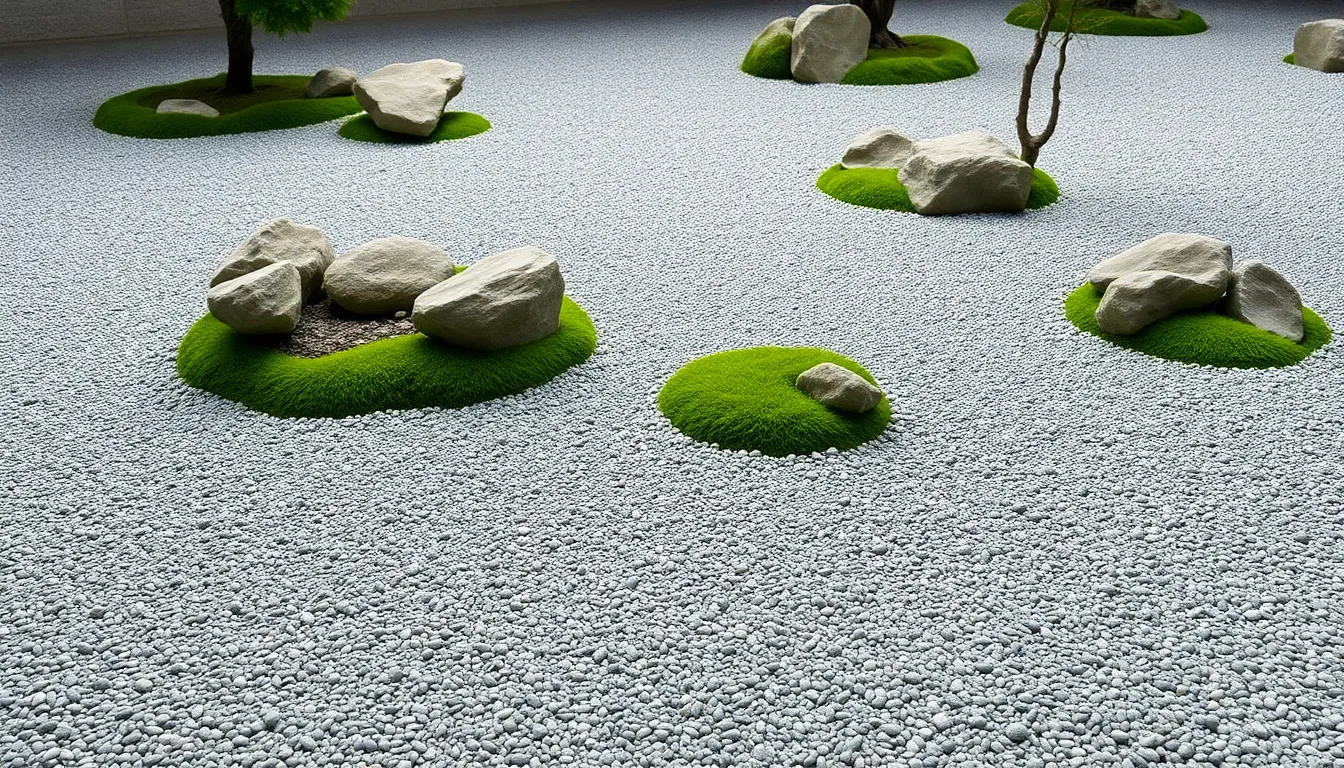
Transform your front yard into a tranquil retreat with gravel that mimics traditional Japanese design principles. We’ll show you how to create this serene industry using three essential elements.
Select Fine Pea Gravel for Raking Patterns
Fine pea gravel serves as the foundation for authentic Zen garden aesthetics. We recommend choosing smooth, uniform stones that allow for effortless raking and pattern creation. This gravel type enables you to design intricate flowing patterns that represent water movement, bringing a meditative quality to your entrance.
Raking becomes a therapeutic maintenance ritual rather than a chore. The small, rounded stones shift easily under garden rakes, letting you create flowing lines that curve around larger elements. You can redesign these patterns weekly or seasonally, keeping your garden’s appearance fresh and personally meaningful.
Drainage benefits make fine pea gravel both beautiful and functional. Water flows through these stones naturally, preventing puddles while maintaining the clean lines of your design. This characteristic proves especially valuable during rainy seasons when traditional gardens might look muddy or unkempt.
Place Strategic Boulder Accents
Larger stones create focal points that anchor your entire design composition. We suggest positioning 2-3 substantial boulders asymmetrically throughout your gravel space to establish visual hierarchy. These elements represent mountains or islands in traditional Japanese gardens, adding depth and contemplative focus to your front yard.
Positioning matters more than size when selecting boulder placements. Place your largest stone slightly off center to create natural balance, then arrange smaller accent stones to support this primary element. The contrast between smooth gravel and rough boulder textures enhances the garden’s visual appeal while maintaining its minimalist philosophy.
Natural weathering on boulders adds authentic character over time. Choose stones with interesting shapes, colors, or moss growth that’ll develop more personality as seasons change. This aging process aligns with Japanese design principles that celebrate natural imperfection and the passage of time.
Include Minimal Plant Elements
Moss introduces subtle green accents without overwhelming the peaceful atmosphere. We recommend establishing small moss patches around boulder bases or in naturally shaded areas where it’ll thrive with minimal care. This plant choice stays true to traditional Zen garden aesthetics while adding living texture to your gravel industry.
Small shrubs provide structure when placed sparingly throughout the space. Consider adding 1-2 compact evergreen plants like dwarf conifers or small boxwood specimens to create vertical interest. These selections maintain their shape year round, ensuring your garden looks intentional during every season.
Minimalist grasses offer gentle movement that complements static gravel patterns. Ornamental grasses like fountain grass or Japanese forest grass bring subtle motion when breezes pass through your garden. Their soft texture contrasts beautifully with hard gravel surfaces while requiring very little maintenance beyond annual trimming.
Establish a Cottage Garden With Gravel Pathways
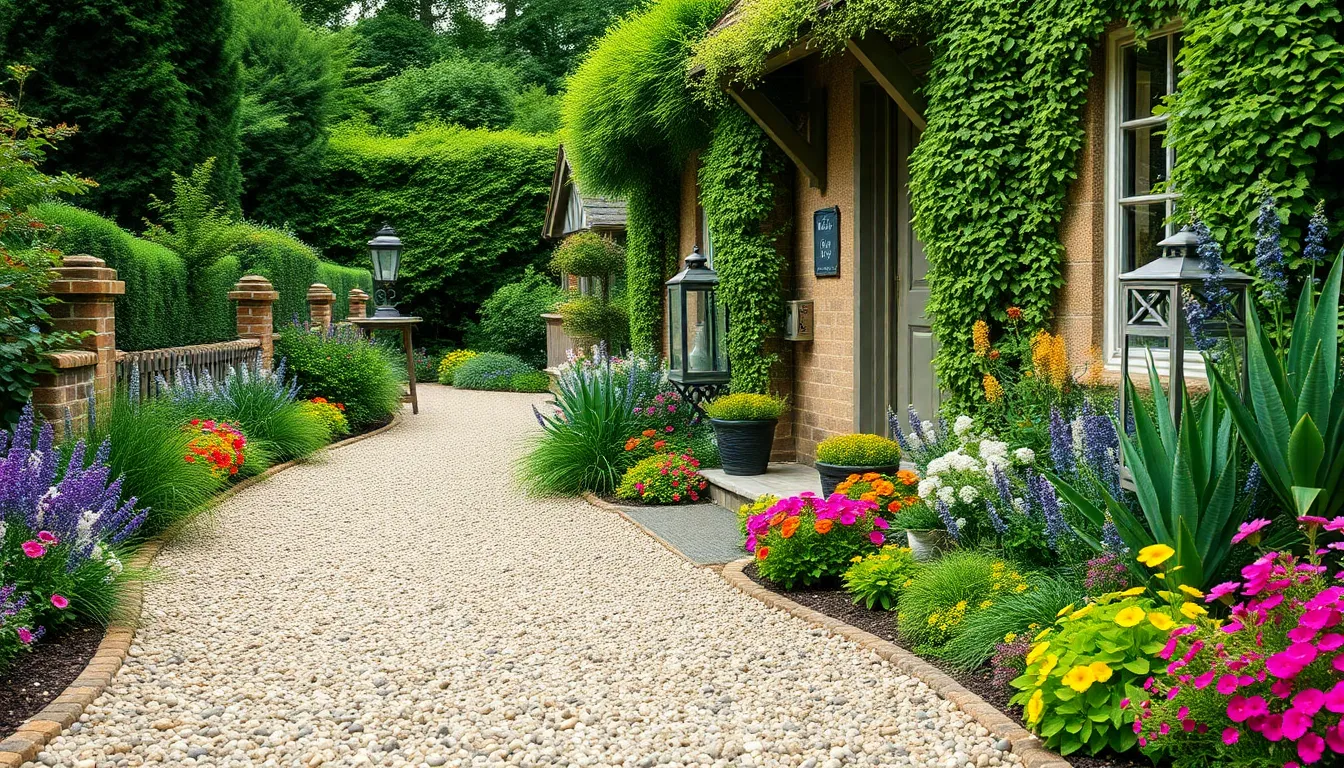
Cottage gardens with gravel pathways bring timeless charm to your front yard while providing practical walkways that guide visitors through your industry. We’ll show you how to create this classic look using strategic gravel placement and thoughtful plant combinations.
Mix Different Gravel Sizes for Texture
Different gravel sizes create visual depth and serve exact functional purposes in your cottage garden design. Combining 10mm and 20mm gravel adds dimensional interest while addressing various practical needs throughout your space.
Larger gravel works best for main pathways since 20mm stones provide stable footing and handle foot traffic effectively. We recommend using this size for your primary walkways where guests will travel most frequently.
Finer gravel suits seating areas and decorative zones where comfort matters more than durability. Smaller 10mm stones create softer surfaces around benches or garden focal points.
Mixing sizes within the same pathway adds natural variation that mimics countryside lanes. Start with larger stones as your base layer then scatter smaller gravel on top for a weathered appearance.
Plant Wildflowers Between Gravel Sections
Wildflowers thriving between gravel sections create the quintessential cottage garden atmosphere while requiring minimal maintenance. Hardy species adapt well to gravel conditions and provide seasonal color throughout the year.
Creeping thyme (Thymus coccineus) releases fragrant scents when visitors step on the leaves along your pathways. This low-growing perennial spreads naturally between gravel stones and produces tiny purple flowers in summer.
Acaena varieties tolerate foot traffic and develop interesting bronze foliage that contrasts beautifully with neutral gravel tones. These plants self-seed readily and fill gaps without overwhelming your design.
Ficaria verna ‘Coppernob’ adds vibrant early spring color with bright yellow blooms that appear before most other garden plants wake up. We love how this wildflower naturalizes quickly and requires virtually no care once established.
Create Winding Paths to Front Door
Winding paths transform your entrance into an inviting journey rather than a direct route to your door. Curved walkways using gravel create anticipation and allow visitors to appreciate your garden from multiple angles.
Design gentle curves that feel natural by following the existing contours of your industry or creating subtle elevation changes. Avoid sharp turns that feel forced or difficult to navigate comfortably.
Define path edges with brick or stone borders to prevent gravel from spreading into planted areas while adding architectural interest. These boundaries also help maintain clean lines as your cottage garden matures.
Add decorative elements like lanterns or small sculptures at key points along your winding path to create focal points and enhance the journey experience. Strategic placement of these features guides visitors naturally toward your front door while showcasing your garden’s charm.
Construct a Formal Victorian-Style Gravel Garden
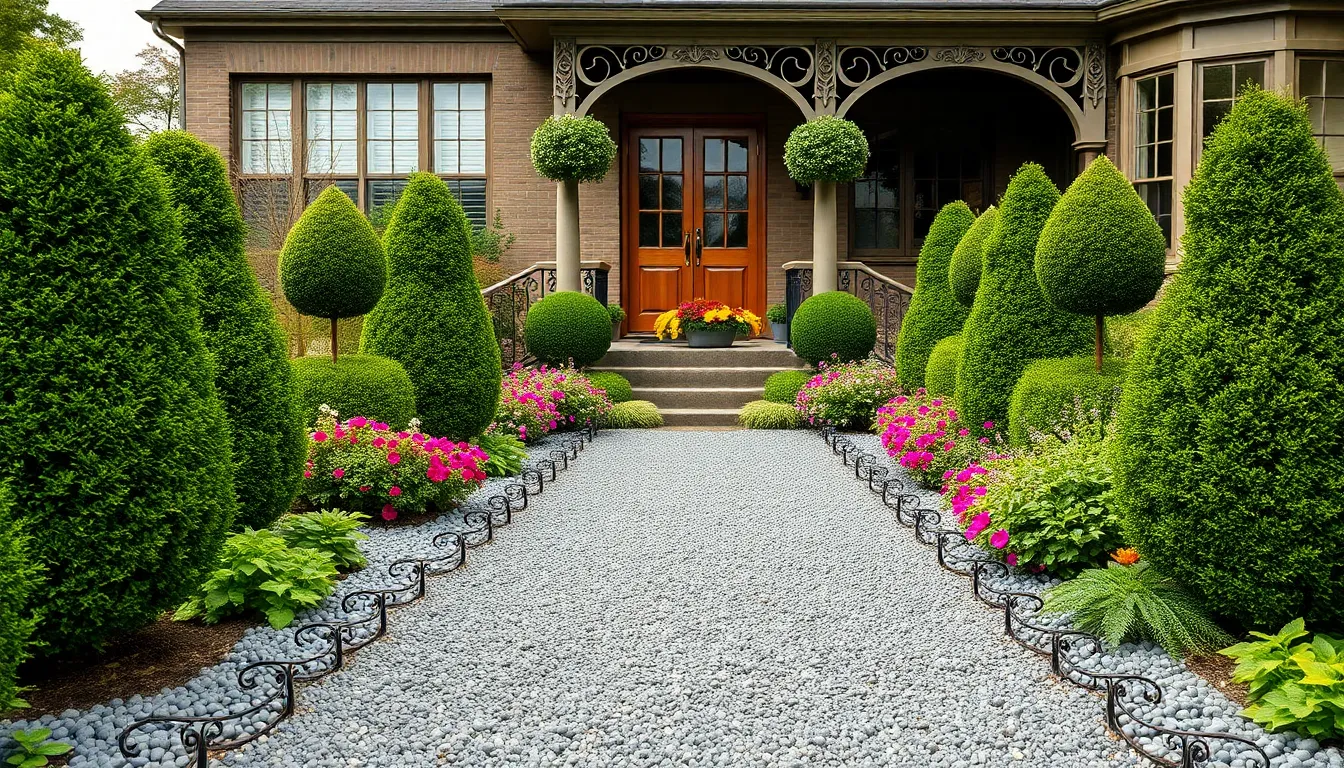
Victorian elegance transforms any front yard into a sophisticated statement that captures 19th-century grandeur. This formal approach creates structure and timeless appeal through carefully planned design elements.
Use Traditional Gray Gravel Base
Gray gravel serves as the perfect foundation for authentic Victorian garden aesthetics. We recommend spreading this neutral tone evenly across your entire garden space to create the uniform surface that defines formal garden design. Traditional gray provides the ideal backdrop for ornamental features while complementing various plant species commonly found in Victorian landscapes.
Fine to medium-sized gray stones work best for achieving that classic look without overwhelming other design elements. Larger gray pebbles can create texture variation while maintaining the sophisticated color palette that Victorian gardens are known for. Uniform distribution ensures your gravel base supports the formal structure while providing excellent drainage for your plants.
Install Ornate Metal Edging
Ornate metal edging defines garden boundaries while adding the decorative metalwork that Victorian gardens celebrated. We suggest installing wrought iron style borders around your garden perimeter to capture that authentic 19th-century elegance. Decorative metal elements can feature intricate patterns or simple geometric designs that complement your home’s architectural style.
Victorian gardens often showcased elaborate metalwork through fencing and garden borders that served both functional and aesthetic purposes. Metal edging provides clean lines that separate your gravel areas from lawn or planting beds while introducing that essential ornamental quality. Choose weather-resistant materials that’ll maintain their appearance through seasonal changes while providing long-lasting definition for your formal garden space.
Add Symmetrical Topiary Elements
Symmetrical topiary creates the structured formality that defines Victorian garden design principles. We recommend using boxwood or yew plants shaped into geometric forms like spheres, cones, or spirals placed at regular intervals throughout your garden. Strategic placement along pathways or around central features maintains the balanced composition that formal gardens require.
Matching pairs of topiaries work exceptionally well flanking entrance points or garden focal areas to establish visual rhythm. Regular maintenance keeps these living sculptures in perfect shape while preserving the neat appearance that Victorian formality demands. Topiary elements serve as anchor points that organize your garden space while providing year-round structure and visual interest that complements your gray gravel foundation.
Install a Sustainable Xerophytic Gravel Landscape
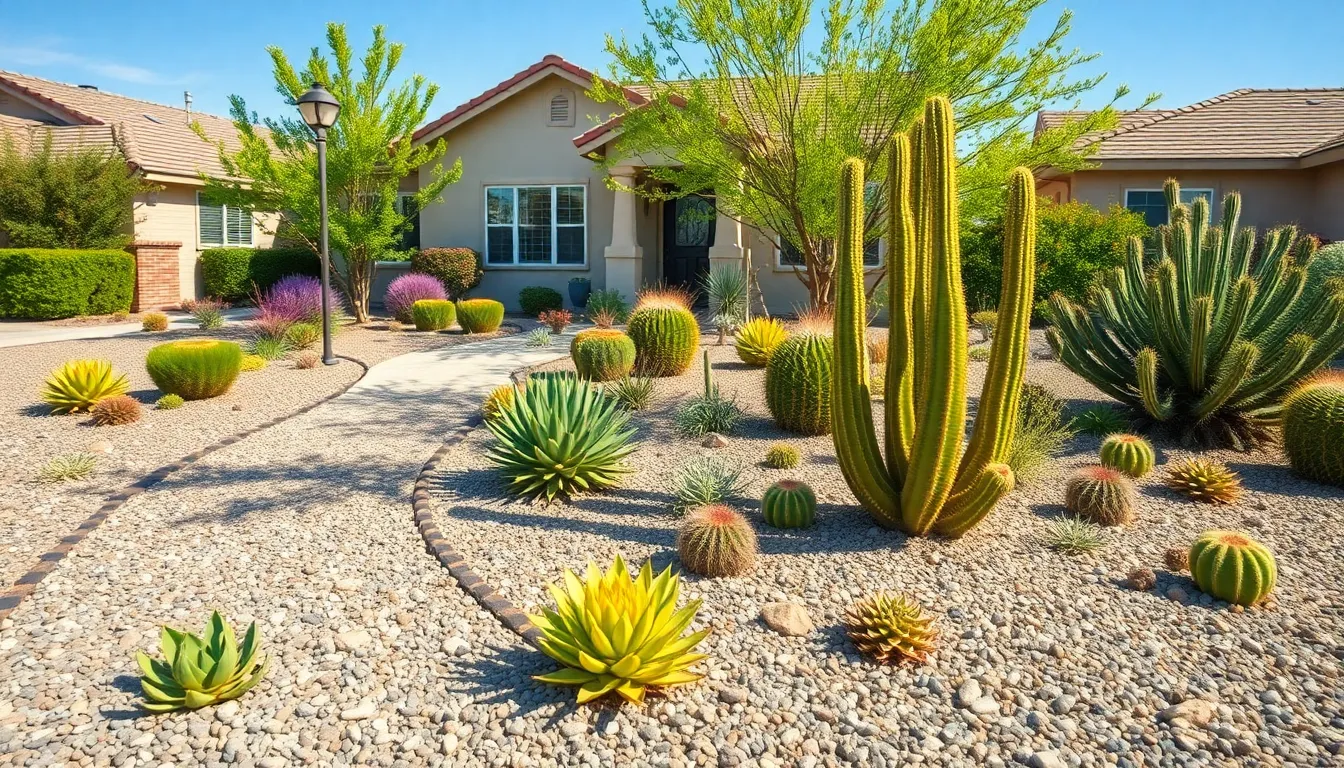
Creating an eco-friendly xerophytic gravel garden combines environmental responsibility with stunning visual appeal. This approach prioritizes water conservation and local network support while maintaining the low-maintenance benefits that make gravel landscaping so attractive.
Choose Local Gravel Materials
Select 20mm-sized gravel from local suppliers to ensure optimal functionality and sustainability. This exact size provides excellent stability for walking while creating an attractive surface texture that complements xerophytic plants. Local materials significantly reduce transportation distances and environmental impact while supporting regional businesses.
Durability becomes a key advantage when you choose properly sized gravel that naturally suppresses weed growth. The 20mm stones create enough coverage to block sunlight from reaching weed seeds while allowing water to penetrate effectively. Maintenance requirements drop dramatically compared to traditional landscaping options.
Water consumption decreases substantially with gravel surfaces that don’t require irrigation like grass lawns. The material reflects heat during summer months and provides excellent drainage during rainy seasons. Cost savings accumulate over time through reduced water bills and minimal upkeep needs.
Plant Native Succulents and Cacti
Native drought-resistant species thrive in gravel environments without additional water beyond natural rainfall. These plants have evolved to handle local climate conditions including temperature extremes and seasonal variations. Examples include barrel cacti, prickly pear, and various agave species depending on your region.
Local pollinators benefit significantly from native succulent flowers that provide nectar during blooming seasons. Bees and butterflies particularly favor these plants because they’ve co-evolved together over thousands of years. Supporting native wildlife creates a balanced network in your front garden.
Groundcover options like creeping thyme or acaena work exceptionally well in high-traffic areas where foot traffic occurs regularly. These hardy plants spread naturally to create living carpets between gravel sections. Their resilience makes them perfect for pathways and entrance areas.
Carry out Rainwater Collection Features
Rain barrels capture and store precipitation for future irrigation needs during dry periods. Position these containers strategically near downspouts or natural water collection points in your industry design. A single inch of rainfall on a 1,000-square-foot roof generates approximately 600 gallons of harvestable water.
Underground storage tanks offer discrete collection without compromising your garden’s visual appeal. These systems can hold significantly more water than surface barrels while maintaining a clean aesthetic. Integration with decorative planters creates functional beauty that serves multiple purposes.
Stone mulching around plant beds retains collected moisture while suppressing unwanted vegetation growth. This technique elevates the garden’s visual appeal through contrasting textures and colors. The combination of rainwater harvesting and mulching maximizes resource efficiency throughout the growing season.
Create Multi-Level Terraced Gravel Gardens
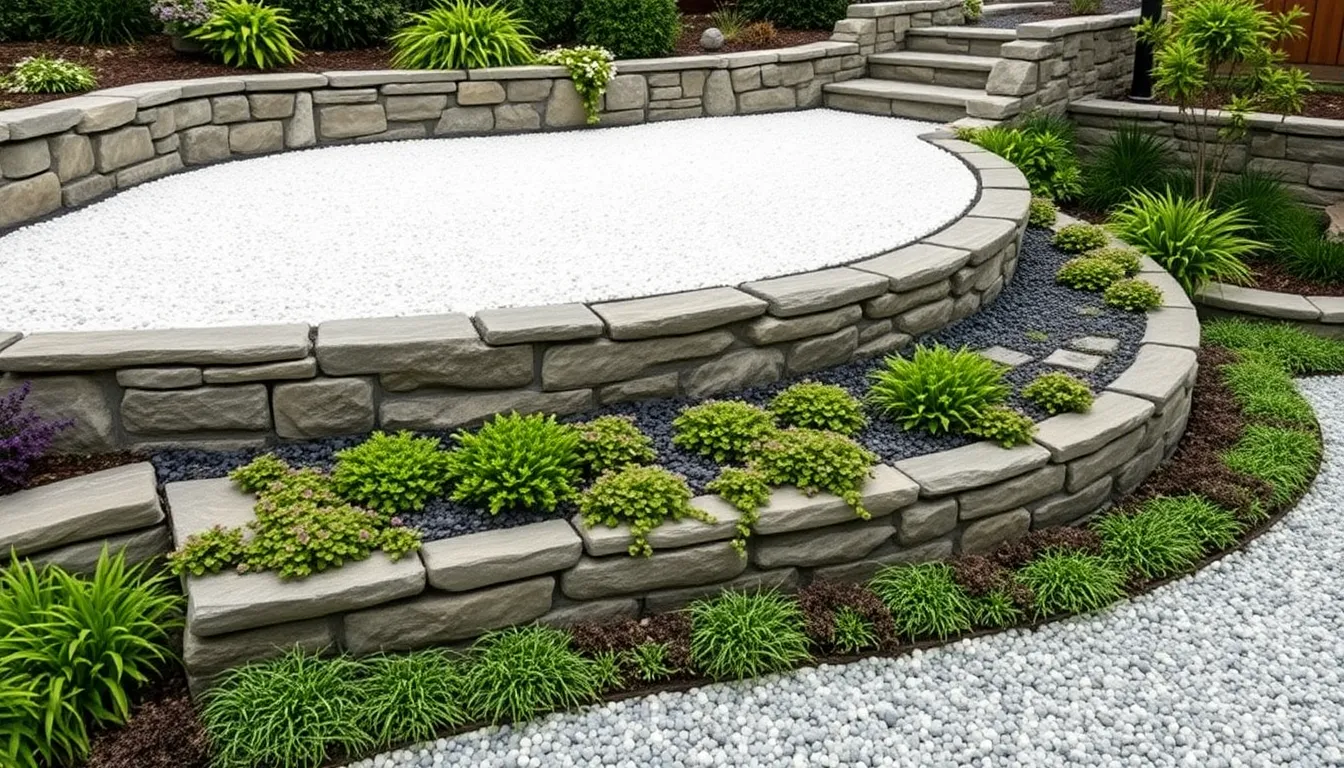
Transform sloped front yards into stunning multi-dimensional landscapes by excavating the slope to create level surfaces for each terrace. This approach allows for multiple flat areas that can accommodate different garden features like seating areas, planting zones, or decorative elements.
Build Retaining Walls for Elevation Changes
Constructing sturdy retaining walls forms the backbone of successful terraced gravel gardens. Pressure-treated wood sleepers offer an affordable solution that blends naturally with garden environments while providing essential structural support. Stone retaining walls deliver superior durability and create sophisticated visual appeal that complements any gravel color scheme.
Engineering these walls properly ensures they can handle the weight of gravel and manage water runoff effectively. We recommend consulting local building codes since retaining walls over certain heights may require permits or professional engineering. Proper drainage behind retaining walls prevents water buildup that could compromise structural integrity over time.
Use Contrasting Gravel Colors by Level
Selecting different gravel colors for each terrace level creates striking visual differentiation that enhances your garden’s depth and dimension. Lighter gravel colors like white marble chips or pale limestone work beautifully on upper terraces, where they catch sunlight and create bright focal points. Darker gravel tones such as charcoal or deep gray provide elegant contrast on lower levels, grounding the design with sophisticated base colors.
| Terrace Level | Recommended Gravel Colors | Visual Effect |
|---|---|---|
| Upper levels | White marble, pale limestone | Bright, eye-catching |
| Middle levels | Medium gray, buff tones | Transitional balance |
| Lower levels | Charcoal, deep brown | Grounding, sophisticated |
Mixing complementary colors between adjacent levels creates smooth transitions while maintaining distinct boundaries. This color gradation technique draws the eye naturally through your garden’s vertical industry.
Plant Cascading Ground Cover
Incorporating cascading ground cover plants softens the hard edges of retaining walls while creating natural flowing connections between terrace levels. Creeping thyme thrives in gravel conditions and produces fragrant purple flowers that attract beneficial pollinators to your front garden. Sedum varieties offer colorful foliage and star-shaped blooms that require minimal maintenance once established.
These plants spill gracefully over terrace edges, creating organic waterfalls of greenery that complement the structured geometry of your gravel levels. Hardy ground covers like creeping phlox or moss pink add seasonal color bursts while tolerating the excellent drainage that gravel gardens provide. Position these plants strategically at terrace corners and edges where their cascading growth habit creates maximum visual impact.
Design a Child-Friendly Play Area With Decorative Gravel
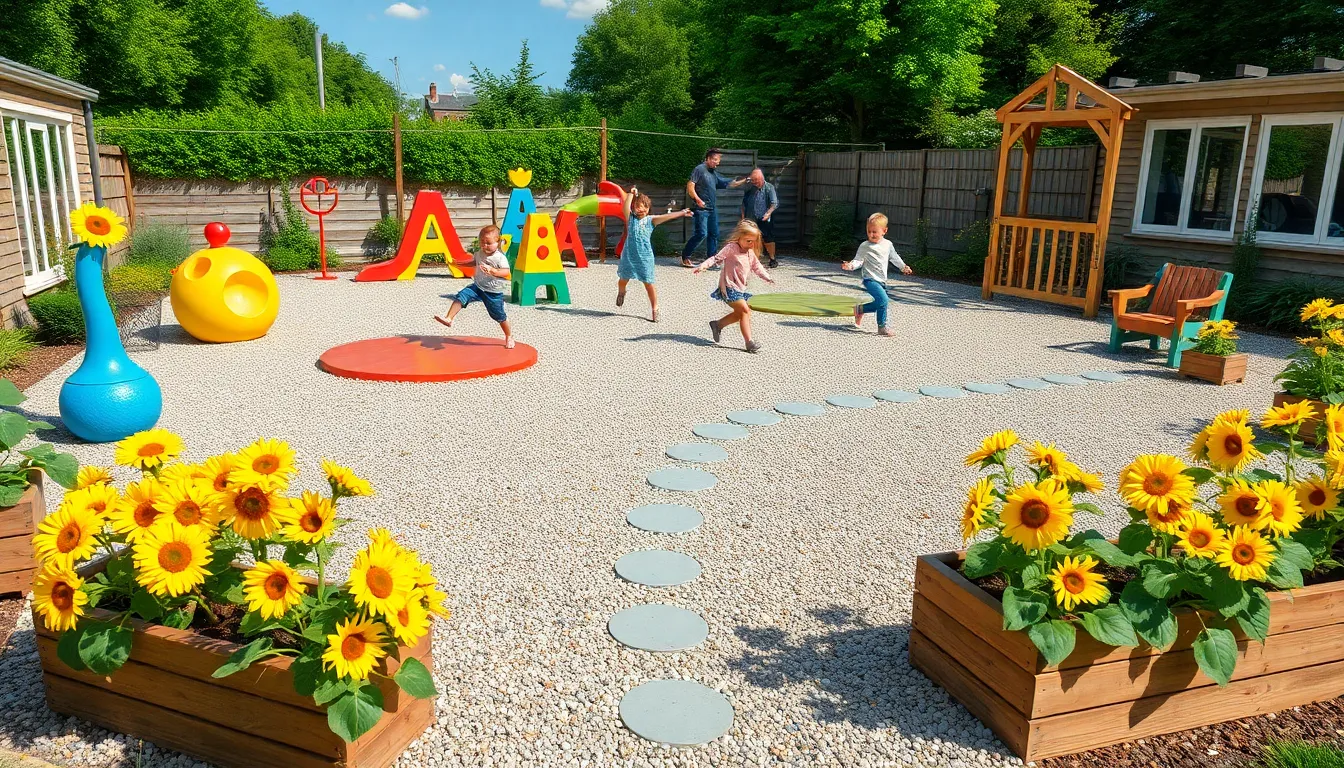
Transforming your front yard gravel garden into a safe and captivating space for children requires thoughtful material selection and strategic design planning. We’ll explore how decorative gravel can create functional play areas that blend seamlessly with your overall industry design.
Select Rounded Pea Gravel for Safety
Rounded pea gravel serves as the safest foundation material for children’s play areas due to its naturally smooth surface that feels comfortable underfoot. We recommend this child and pet friendly option over angular gravel types that can cause discomfort or minor injuries during active play. Small stones measuring 3/8 to 5/8 inches provide the ideal balance between stability and cushioning for running games and outdoor activities.
Pathways created with rounded pea gravel offer excellent traction while remaining gentle on bare feet during summer play sessions. Comfort levels increase significantly when children walk or play on this softer gravel surface compared to sharp edged alternatives. Safety considerations extend beyond texture since rounded stones are less likely to scatter dangerously when kicked or thrown during energetic play.
Create Defined Play Zones
Dividing your gravel garden into distinct activity areas helps organize different types of childhood entertainment while maintaining visual cohesion throughout the space. We suggest establishing separate zones for active play like mini obstacle courses alongside quieter areas designated for reading or creative activities. Gravel pathways naturally define these boundaries while allowing flexible transitions between different play experiences.
Active play zones benefit from slightly deeper gravel layers that provide better cushioning for jumping and running activities. Quiet zones can feature finer gravel surfaces that encourage calm activities like drawing with sticks or building small stone sculptures. Strategic placement of these zones creates natural flow patterns that guide children through various play experiences without overwhelming the garden’s aesthetic appeal.
Add Colorful Garden Art Elements
Incorporating vibrant art pieces throughout your gravel play area stimulates creativity while adding visual interest that complements the natural stone palette. We recommend placing colorful sculptures, mosaic stepping stones, or decorative planters along gravel paths to create discovery points that encourage exploration. These artistic elements serve as focal points that draw children’s attention and inspire imaginative play scenarios.
Sculptures designed specifically for outdoor use withstand weather conditions while providing interactive elements like climbing features or musical components. Mosaic installations can include handprints or family artwork that personalizes the space and creates lasting memories. Planters filled with child safe plants like sunflowers or herbs offer educational opportunities about gardening while adding seasonal color changes to maintain year round interest.
Incorporate Water Features Into Gravel Landscapes
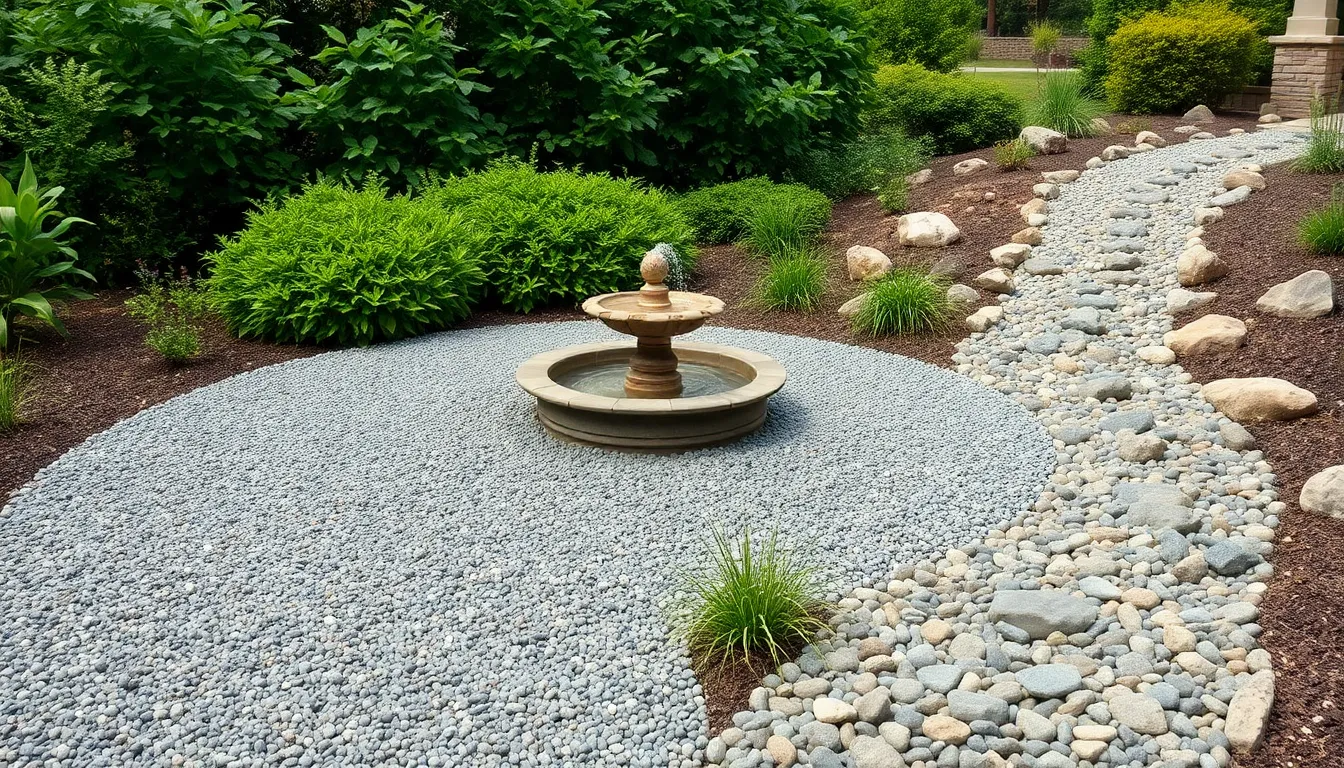
Water elements paired with gravel create stunning focal points that enhance both visual appeal and tranquility in your front garden design.
Install Gravel-Surrounded Fountains
Fountains surrounded by gravel deliver a striking centerpiece that combines the soothing sounds of flowing water with textural contrast. We recommend selecting 20mm gravel sizes around fountain bases for optimal stability and comfortable walking surfaces. Larger gravel prevents scattering and won’t get caught in tire treads if you position fountains near driveways or pathways.
Drainage naturally improves when you surround fountains with gravel, eliminating standing water issues while maintaining the natural aesthetic. Position your fountain centrally within the gravel bed to create balanced visual weight. Choose fountain styles that complement your overall garden theme, whether modern geometric designs or classic tiered structures.
Create Dry Creek Bed Designs
Dry creek beds transform ordinary gravel areas into artistic installations that mimic natural water channels. We suggest mixing different gravel colors and sizes to achieve realistic flowing water effects without actual moisture. These decorative features can guide rainwater runoff or serve purely ornamental purposes throughout your industry.
Native plants and strategic stone placement enhance dry creek bed authenticity while adding vertical interest. Design meandering patterns that follow natural contours of your front yard space. Consider using lighter colored gravels in the center with darker stones along edges to simulate water depth and movement.
Add Reflecting Pools With Gravel Borders
Reflecting pools bordered by clean gravel edges blend still water elegance with rustic charm for sophisticated garden design. Gravel borders provide neat visual definition while preventing muddy conditions around pool perimeters. The textural contrast between smooth water surfaces and rough gravel creates compelling visual interest.
We recommend using uniform gravel sizes around reflecting pools to maintain clean lines and professional appearance. Select colors that complement your water feature materials, such as warm tones with copper accents or cool grays with stainless steel elements. Position reflecting pools where they’ll capture sky and surrounding plantings for maximum visual impact.
Combine Gravel With Hardscaping Elements
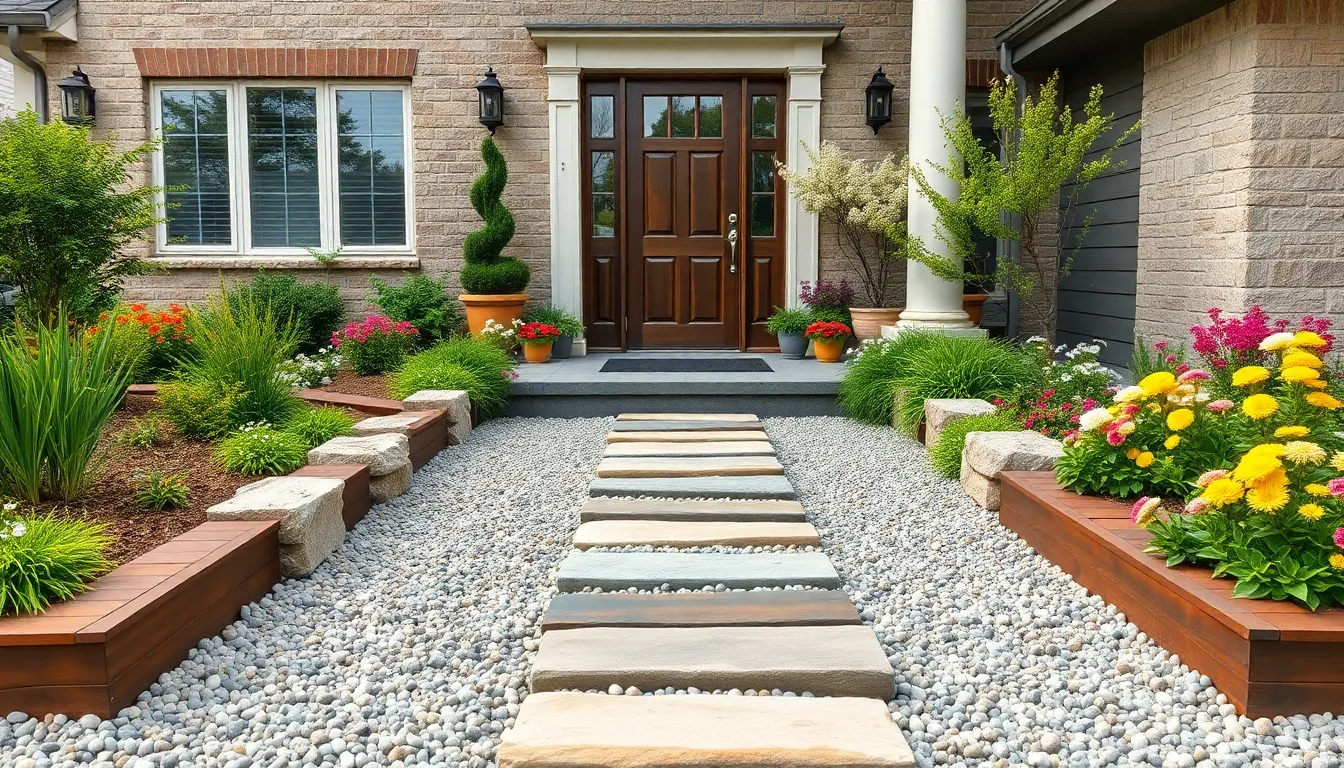
Hardscaping elements provide structure and functionality to gravel gardens while preventing stone displacement. These durable features create defined spaces and enhance visual appeal through material contrast.
Integrate Natural Stone Stepping Stones
Natural stone stepping stones guide visitors through gravel areas while providing stable footing on uneven surfaces. We recommend spacing stones 18 to 24 inches apart for comfortable walking stride patterns across different gravel textures.
Placement of stepping stones creates visual pathways that draw the eye toward focal points like front doors or garden features. Flagstone, slate, and sandstone options offer varying colors and textures that complement different gravel types and architectural styles.
Texture contrast between smooth stone surfaces and surrounding gravel adds dimensional interest to flat garden spaces. Large irregular stones create rustic charm while cut geometric shapes provide contemporary clean lines for modern front yard designs.
Installation involves setting stones slightly below gravel level to prevent tripping hazards and ensure long term stability. We suggest using a sand base beneath each stone for proper drainage and level positioning within the gravel bed.
Add Wooden Deck Sections
Wooden deck sections create defined seating and lounging zones within gravel landscapes while adding warm natural tones. These raised platforms provide comfortable spaces for outdoor furniture and entertaining areas that contrast beautifully with cool gravel colors.
Materials like cedar, teak, and pressure treated lumber offer different durability levels and aesthetic qualities for various climate conditions. We recommend cedar for its natural weather resistance and attractive grain patterns that complement both light and dark gravel choices.
Positioning deck sections adjacent to gravel areas creates seamless transitions between hardscape and softscape elements. Elevated platforms also improve drainage around seating areas while protecting wooden surfaces from direct ground contact and moisture buildup.
Construction details include proper foundation support and adequate spacing between deck boards for water drainage beneath the structure. We suggest installing deck sections at slight angles to direct rainwater toward gravel areas for natural irrigation benefits.
Install Decorative Concrete Borders
Decorative concrete borders create clean separation lines between gravel areas and surrounding industry features like lawns or flower beds. These permanent edges prevent gravel migration while contributing to polished modern garden aesthetics.
Stamped concrete patterns offer texture options that mimic natural stone, brick, or geometric designs to match various architectural styles. We recommend colored concrete that complements existing hardscape elements while providing subtle contrast with gravel tones.
Border installation involves excavating trenches and pouring concrete foundations that extend below frost lines for long term stability. Proper reinforcement with rebar or mesh prevents cracking from ground movement and seasonal temperature changes.
Maintenance benefits include reduced edge trimming requirements and eliminated need for frequent gravel repositioning along garden boundaries. These borders also provide raised barriers that direct water flow and prevent soil erosion into gravel beds during heavy rainfall.
Conclusion
We’ve explored countless ways to transform your front garden with gravel – from sleek modern minimalism to charming cottage pathways. Each design style offers unique benefits while maintaining that low-maintenance appeal we all crave.
The versatility of gravel means you can create stunning landscapes regardless of your budget climate or soil conditions. Whether you’re drawn to Mediterranean courtyards Japanese zen gardens or child-friendly play areas there’s a gravel solution that fits your lifestyle.
Remember that successful gravel gardens combine functionality with beauty. By choosing the right gravel sizes incorporating complementary plants and adding thoughtful hardscaping elements you’ll create an entrance that welcomes guests while requiring minimal upkeep throughout the seasons.
Frequently Asked Questions
What are the main benefits of gravel landscaping for front yards?
Gravel landscaping offers exceptional low-maintenance benefits, making it perfect for busy homeowners. It requires minimal watering, weeding, and upkeep compared to traditional lawns. Gravel also provides excellent drainage, prevents soil erosion, and works well in challenging conditions like poor soil or drought areas. Plus, it’s cost-effective and adds instant curb appeal with various design possibilities.
What type of gravel is best for modern minimalist designs?
Light-colored gravel works best for modern minimalist designs. White marble chips and pale limestone create a bright, sophisticated aesthetic that enhances clean lines. These materials reflect light beautifully and complement geometric planters and structured design elements. The key is maintaining uniformity in color and size for that sleek, contemporary look.
How do I create a Mediterranean-inspired gravel garden?
Use warm terra cotta and cream gravel tones mixed together for depth and visual interest. Incorporate different gravel sizes for texture variation. Plant drought-resistant species like lavender as centerpieces, complemented by alliums and agapanthus. Add natural stone borders for structure and definition, creating an elegant entrance reminiscent of coastal Mediterranean landscapes.
What makes a Japanese Zen gravel garden low-maintenance?
Japanese Zen gardens use fine pea gravel that can be raked into patterns mimicking water movement, requiring only occasional maintenance. Larger boulders serve as focal points, while minimal plant elements like moss, compact evergreens, and ornamental grasses maintain tranquility without extensive care. The weathered, natural look actually improves over time.
How do I design safe gravel play areas for children?
Use rounded pea gravel for safety, as its smooth surface is comfortable for children and pets. Create defined play zones with deeper gravel layers for active play and finer surfaces for quieter activities. Incorporate colorful garden art elements to stimulate creativity while maintaining the area’s visual appeal and functionality.
What’s the best gravel size for pathways and walkways?
Mix different gravel sizes for optimal functionality. Use larger stones (20-25mm) for main pathways to provide stability and comfort underfoot. Finer gravel (10-15mm) works well for seating areas and decorative sections. This combination creates visual depth while addressing practical walking needs and preventing gravel displacement.
How can I incorporate water features with gravel landscaping?
Surround fountains with 20mm gravel for proper drainage and stability. Create dry creek beds using mixed gravel colors for a natural appearance. For reflecting pools, use uniform gravel borders to maintain clean lines. These water elements enhance tranquility and visual appeal while complementing the gravel’s natural drainage properties.
What hardscaping elements work well with gravel gardens?
Natural stone stepping stones spaced 18-24 inches apart guide visitors comfortably through gravel areas. Wooden deck sections create defined seating areas and add warmth. Decorative concrete borders prevent gravel migration while creating clean separations between different garden features. These elements provide structure and enhance functionality while maintaining aesthetic appeal.

